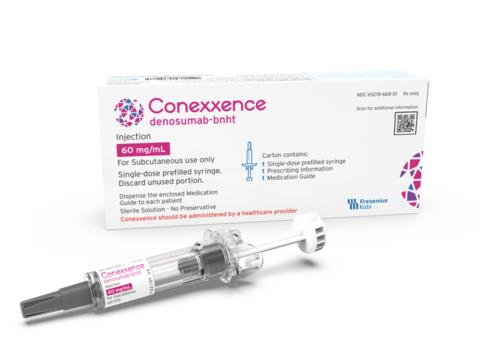Conexxence Dosage
Generic name: Denosumab 60mg in 1mL
Dosage form: injection
Drug class: Miscellaneous bone resorption inhibitors
Medically reviewed by Drugs.com. Last updated on Mar 31, 2025.
Pregnancy Testing Prior to Initiation of Conexxence
Pregnancy must be ruled out prior to administration of Conexxence. Perform pregnancy testing in all females of reproductive potential prior to administration of Conexxence. Based on findings in animals, denosumab products can cause fetal harm when administered to pregnant women.
Laboratory Testing in Patients with Advanced Chronic Kidney Disease Prior to Initiation of Conexxence
In patients with advanced chronic kidney disease [i.e., estimated glomerular filtration rate (eGFR) < 30 mL/min/1.73 m2], including dialysis-dependent patients, evaluate for the presence of chronic kidney disease mineral and bone disorder (CKD-MBD) with intact parathyroid hormone (iPTH), serum calcium, 25(OH) vitamin D, and 1,25 (OH)2 vitamin D prior to decisions regarding Conexxence treatment. Consider also assessing bone turnover status (serum markers of bone turnover or bone biopsy) to evaluate the underlying bone disease that may be present.
Recommended Dosage
Conexxence should be administered by a healthcare provider.
The recommended dose of Conexxence is 60 mg administered as a single subcutaneous injection once every 6 months. Administer Conexxence via subcutaneous injection in the upper arm, the upper thigh, or the abdomen. All patients should receive calcium 1000 mg daily and at least 400 IU vitamin D daily.
If a dose of Conexxence is missed, administer the injection as soon as the patient is available. Thereafter, schedule injections every 6 months from the date of the last injection.
Preparation and Administration
Parenteral drug products should be inspected visually for particulate matter and discoloration prior to administration, whenever solution and container permit. Conexxence is a clear, colorless to pale yellow solution that is free from visible particles. Do not use if the solution is discolored or cloudy or if the solution contains particles or foreign particulate matter.
Prior to administration, Conexxence may be removed from the refrigerator and brought to room temperature (up to 25°C/77°F) by standing in the original container. This generally takes 15 to 30 minutes. Do not warm Conexxence in any other way. Do not shake the prefilled syringe.
Instructions for Administration of Conexxence Prefilled Syringe with Needle Safety Guard
IMPORTANT:
In order to minimize accidental needlesticks, the Conexxence single-dose prefilled syringe has an automatic clear needle safety guard.
Conexxence prefilled syringe (Before & After Use). See figure below.
 |
|
| Step 1: Remove Needle Cap (see Figure A) Do not hold the prefilled syringe by the plunger rod. Do not twist or bend the needle cap. |
|
| Step 2: Administer Subcutaneous Injection Choose an injection site. The recommended injection sites for Conexxence include (see Figure B): |
|
|
|
| Do not administer into muscle or blood vessel. Pinch the skin and insert the needle at a 45 to 90-degree angle. Push the plunger with a slow and constant pressure until you cannot press further and have injected all the liquid subcutaneously (see Figure C). You may hear or feel a “click”. |
|
| Step 3. Release Plunger Keeping the prefilled syringe at the injection site, slowly release the plunger and lift syringe off the skin. The clear needle guard will automatically cover the needle (see Figure D). |
|
| Do not recap the needle. Immediately dispose of the used prefilled syringe into a sharps disposal container. |
|
Frequently asked questions
- What biosimilars have been approved in the United States?
- How many years should you take Prolia?
- How long should you take Xgeva for?
- Is Xgeva a chemotherapy drug?
- Does Xgeva cause bone pain?
- Does Xgeva cause low blood pressure?
More about Conexxence (denosumab)
- Check interactions
- Compare alternatives
- Drug images
- Latest FDA alerts (1)
- Side effects
- During pregnancy
- Drug class: miscellaneous bone resorption inhibitors
- Breastfeeding
Patient resources
Other brands
Prolia, Xgeva, Jubbonti, Wyost
Professional resources
Other brands
Prolia, Xgeva, Jubbonti, Wyost, ... +5 more
Related treatment guides
See also:
Further information
Always consult your healthcare provider to ensure the information displayed on this page applies to your personal circumstances.






